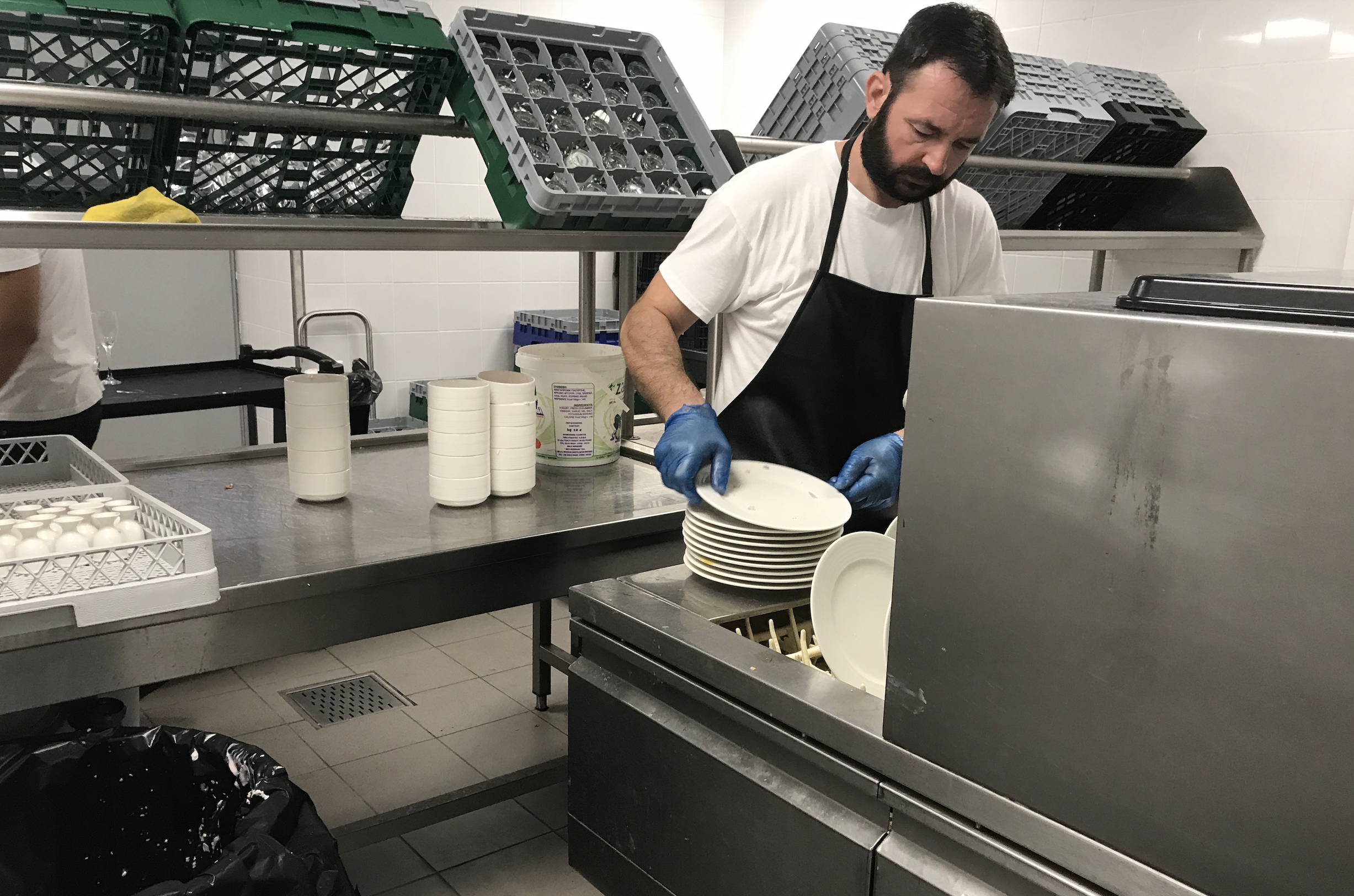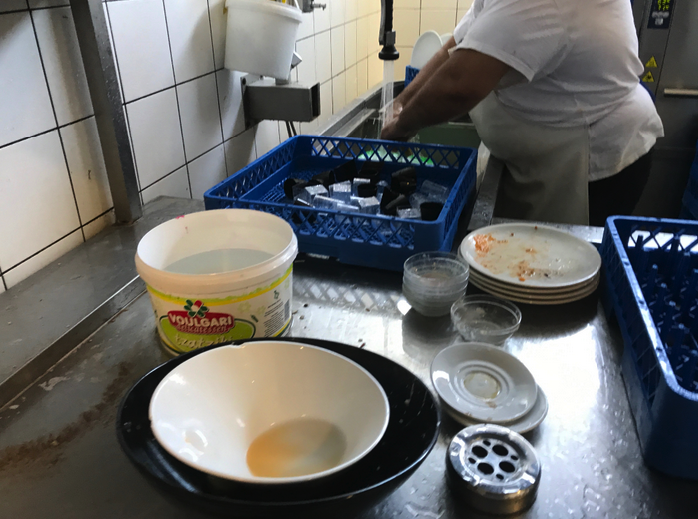Rinsing load

Definition of flushing load
Washing load refers to the mechanical stress placed on the wash ware, in this case porcelain and other ceramic crockery, by the cleaning process in the kitchen. Machine washing places different demands on the crockery than washing by hand. There is no risk of porcelain and glass breaking in the dishwasher due to the water pressure. However, damage can be caused by incorrect loading and unloading. Smooth and straight shapes make sorting easier and favour good washing and drying results. The material must be able to withstand the changing conditions in the dishwasher, e.g. temperature differences when changing the water.
Dishwasher-safe, dishwasher-safe and dishwasher-resistant
When buying crockery, it makes sense to check its suitability for automatic dishwashing. There are various labels for this. In practice, the terms "dishwasher-safe" and "dishwasher-suitable" are used. The behaviour of wash ware during machine dishwashing depends on the material and the type of manufacturing and processing.
The methods for determining dishwasher resistance are summarised in the DIN EN 12875 standard. This is divided into a test standard and an evaluation standard. Part 1 (DIN ENV 12875-1) - adopted 08/2005 - describes the reference test method. Part 2 (DIN EN 12875-2) - adopted 03/2003 - contains not only the evaluation criteria but also a quality seal with which the crockery tested in accordance with the standard can be labelled. The respective symbol contains the maximum number of wash cycles (between 125 and 1000) that the wash ware in question has undergone without visible changes. The number is visible above the water streams that hit the wash ware.
Source: HEA - Fachgemeinschaft für effiziente Energieanwendung e.V., Berlin
Crockery stress in the dishwasher
Washing is always "stressful" for the items being washed. There is chemical stress from the detergents, thermal stress from temperature changes and drying and mechanical stress. Laboratory tests have shown that washing in professional industrial dishwashers is less stressful for the wash ware than washing in domestic dishwashers. This is mainly due to the washing times. With domestic machines, some wash cycles can take up to 70 minutes or more. In professional appliances such as front loaders or rack feed machines, the load is subjected to much less stress due to short wash cycles of approx. 2 minutes.
Source: Winterhalter Gastronom GmbH, 88074 Meckenbeuren
Holst porcelain via mechanical flushing load
Cleaning or rinsing porcelain is very easy, as even burnt or dried-on residues can be removed quite effortlessly. This is due to the low porosity of the glaze, which is achieved by smooth firing at temperatures above 1,320 °C. A good dishwashing result is extremely important for the guest. It is the calling card of the kitchen and is of great importance for the overall image of a culinary performance.

In our opinion and experience, porcelain is not subject to mechanical wear in a dishwasher! Low-fired ceramics, on the other hand, are. Porcelain is absolutely safe in the dishwasher.
But not in the scullery! If the commercial scullery didn't exist as it is... all manufacturers would sell far less porcelain. The scullery is usually the poor relation in kitchen planning and is given by far the least space in terms of the throughput of all moving parts in the catering area. Sculleries are usually cramped and the rush hour is like a war. Waiters "shoot" the dishes onto the pass, plates pile up on bowls and dishes, cups and saucers clatter in the middle and an organised process is hardly possible. Once the dishes have finally been washed - and are often not even really dry yet - they are stacked and stacked again.
In addition to the usual breakage, which is virtually unavoidable in such work processes, porcelain can be subjected to considerable mechanical stress: By being pushed sideways, the unglazed bases of the upper part are literally pushed and scratched over the surface of the part below. As a result of the post-drying process, the glaze and body are very hot and slightly softer than when cold.
Rinsing water residues and solids bound in grease residues on the unglazed bases were not wiped off and form a mixture of crystalline particles containing lime and quartz. Even residues of sugar or salt contain minimal crystalline particles, which now rub on the underlying glaze like sandpaper. The result is a kind of self-destruction process in which one plate is visibly and significantly damaged by another plate. If chemical stress is added to this purely mechanical stress - which is unfortunately usually the case - glaze corrosion and mechanical damage are added together.
The problem of mechanical stress therefore does not lie with the dishwasher, but exclusively with the dishwashing organisation.
Recommendations for use to reduce the flushing load
If you follow the recommendations below to avoid a rinsing load in the scullery, you will increase the protection of your wash ware against mechanical wear, save a lot of money and actively ensure greater sustainability in your business.
- Ensure there is sufficient space in the dishwashing centre.
- Familiarise the dishwashing staff with detailed instructions.
- Inform the dishwashing staff of the values entrusted to them.
- If possible, organise and separate the types of items to be washed.
- Follow the operating instructions and recommendations of the dishwasher manufacturer.
- Use the detergent recommended by the dishwasher manufacturer.
- Leave the crockery to rest and cool after the dishwasher cycle.
- Wipe the unglazed floors briefly with a dishcloth or pit cloth.
- Stack as low as possible and, if at all, individually and straight from the top.
- Avoid uneven crockery towers.
- Never push the porcelain to the side.
- Never push stacked porcelain over a piece underneath.
Product knowledge - A request to our readers!
Since 1998, we have been cultivating our product knowledge out of a passion for porcelain and the endeavour to share our knowledge about this beautiful and exciting material. In more than 20 years, our information pages have grown into a free online encyclopaedia of porcelain knowledge and now serve as a helpful reference work for dealers, end customers, vocational schools and even competitors. In times of increasingly important reviews on the Internet, we therefore ask you to write us a small review on Google. This will help us to address topics that have not yet been dealt with and to constantly revise this knowledge database. Thank you very much.

